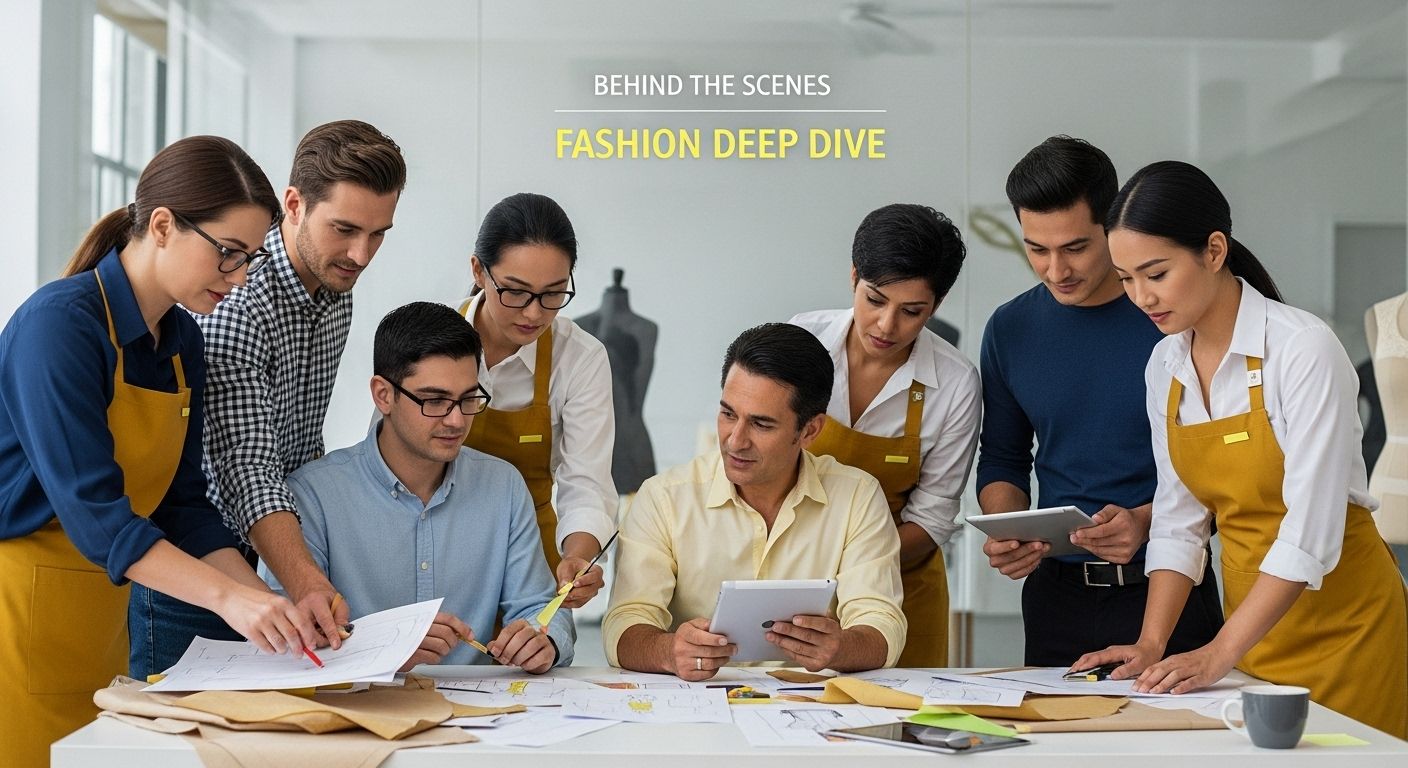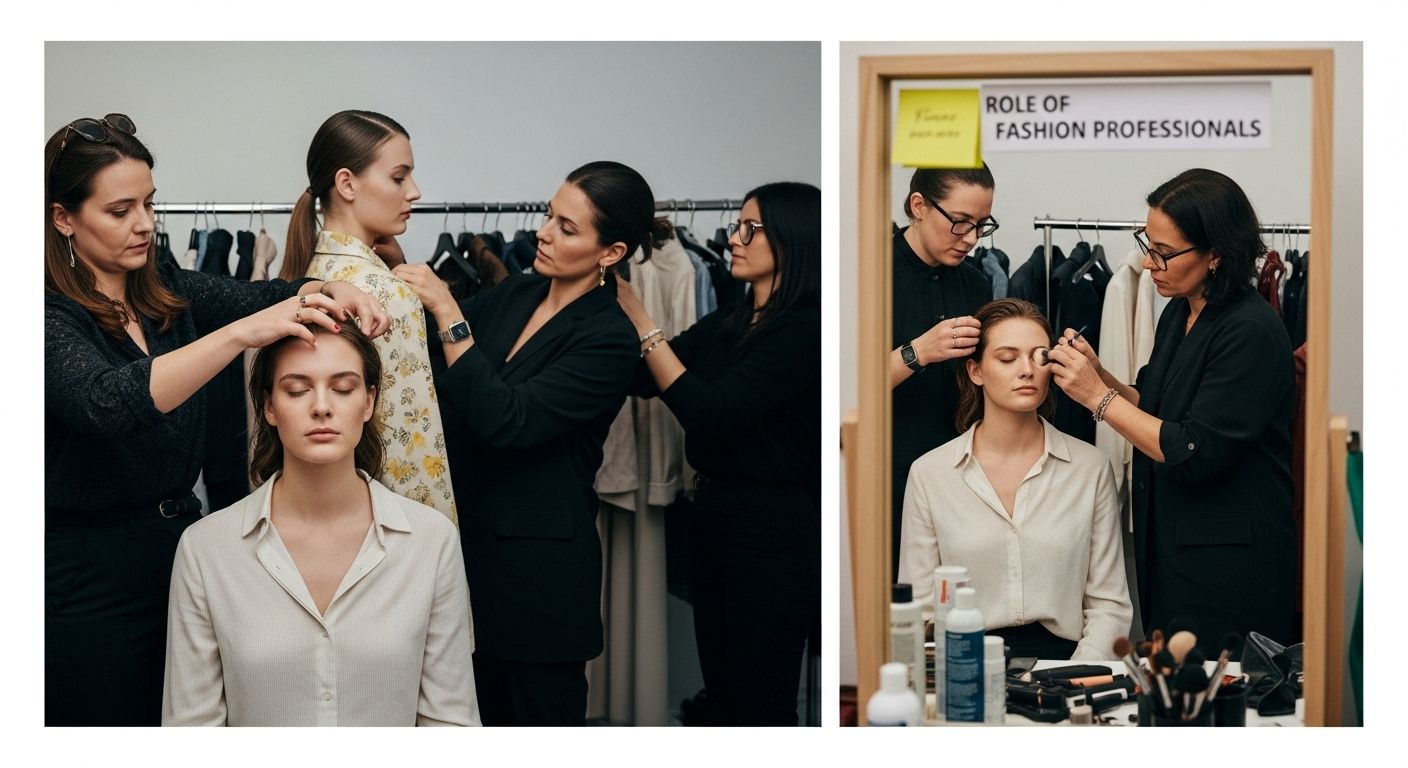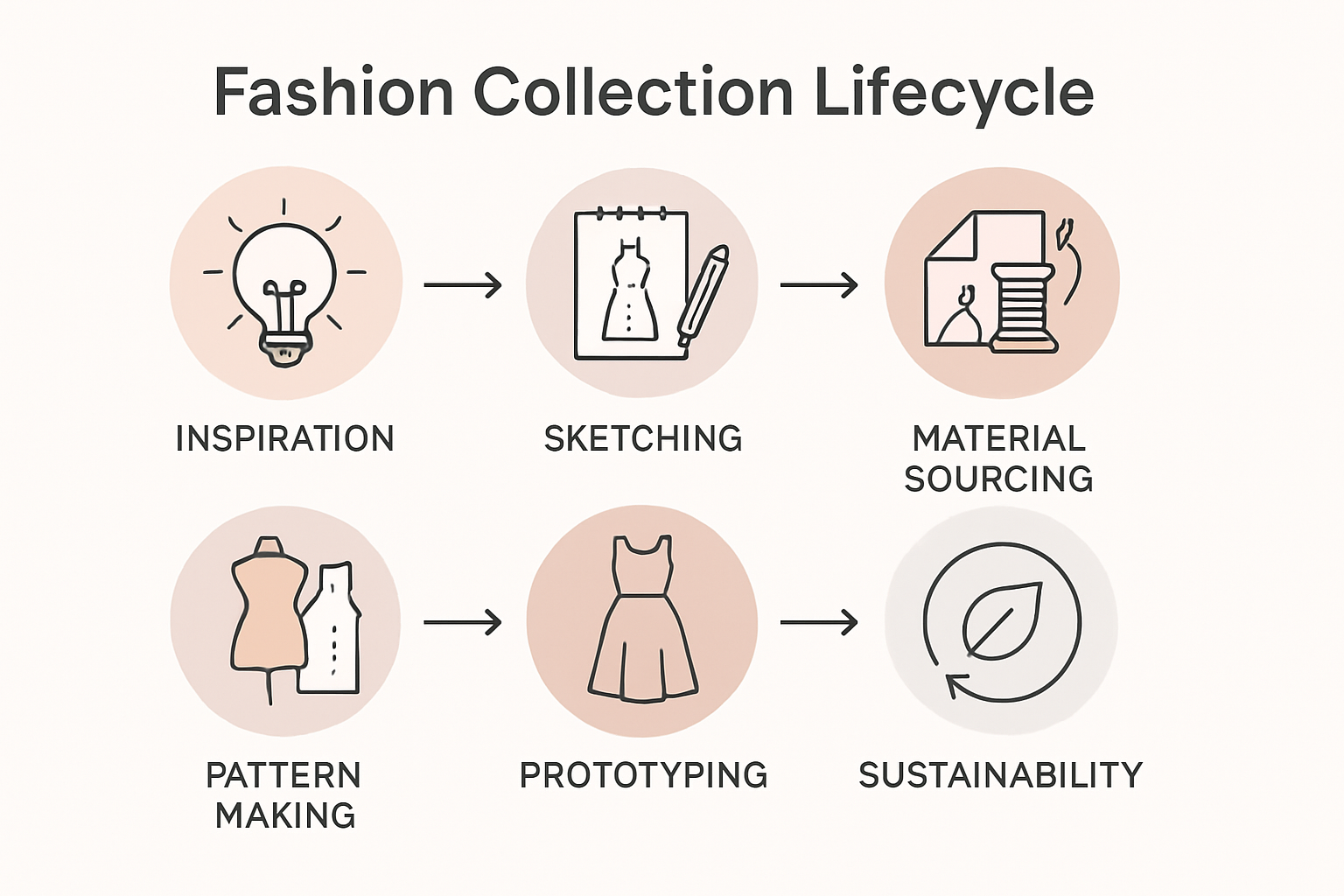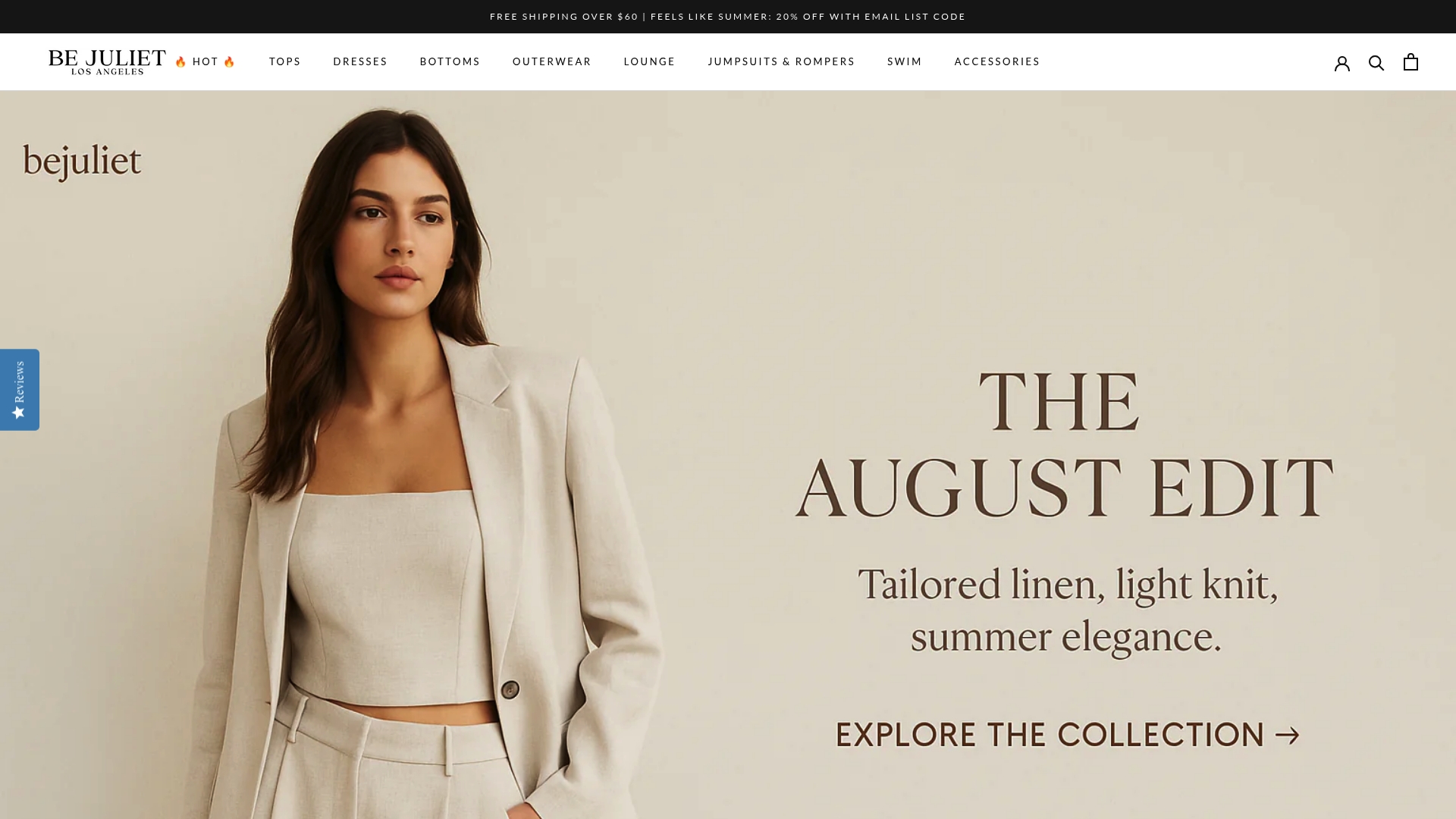Understanding Behind the Scenes Fashion: A Deep Dive
Most people think fashion is just about flashy runways and glossy magazines. But get this. Every single item you wear has passed through dozens of hidden steps involving designers, material experts, and even artificial intelligence. The real magic of fashion happens away from the spotlight, shaping not just what we wear but how clothing tells stories and tackles things like sustainability and new technology.

Table of Contents
- What Is Behind The Scenes Fashion And Why It Matters?
- The Creative Process: From Concept To Catwalk
- The Role Of Fashion Professionals: Designers To Stylists
- Fashion Production: Materials, Techniques, And Sustainability
- The Influence Of Behind The Scenes Work On Fashion Trends
Quick Summary
| Takeaway | Explanation |
|---|---|
| Behind-the-scenes fashion involves multiple stages. | Understanding design, material sourcing, and production enhances appreciation for fashion’s artistry. |
| Sustainability is central to fashion production today. | Brands are prioritizing ethical practices and eco-friendly materials, reshaping their production strategies. |
| Collaboration drives fashion creativity. | Designers, stylists, and producers must work together to create cohesive narratives and impactful presentations. |
| Fashion trends emerge from thorough research. | Professionals analyze cultural influences and consumer behavior to anticipate and shape future styles. |
| Digital tools are transforming design processes. | Technologies like 3D modeling and AI streamline creation and enhance innovation in fashion design. |
What is Behind the Scenes Fashion and Why It Matters?
Fashion is far more than glamorous runway shows and polished photoshoots. Behind the scenes fashion represents the intricate, complex world of creative and logistical processes that transform raw ideas into wearable art. This hidden universe encompasses everything from initial design sketches to final product delivery, revealing a sophisticated ecosystem of creativity, skill, and strategic decision making.
The Invisible Architecture of Fashion Production
At its core, behind the scenes fashion involves multiple interconnected stages that rarely see public attention. These stages include:
- Design Conceptualization: Designers translate abstract inspirations into precise technical drawings
- Material Sourcing: Careful selection of fabrics, threads, and sustainable resources
- Pattern Making: Transforming two-dimensional sketches into three-dimensional garment templates
- Prototype Development: Creating initial samples that test design feasibility and aesthetic potential
According to Virginia Commonwealth University, understanding these behind-the-scenes processes reveals the incredible complexity of fashion production. Each garment represents a journey of collaborative creativity, technical precision, and artistic vision.
To better illustrate the steps involved in taking a fashion concept from an idea to reality, the following table summarizes the key stages of behind-the-scenes fashion production.
| Stage | Description |
|---|---|
| Design Conceptualization | Turning inspiration into technical sketches and initial ideas |
| Material Sourcing | Selecting fabrics, threads, and sustainable resources for production |
| Pattern Making | Translating 2D sketches into 3D templates for garment construction |
| Prototype Development | Creating initial samples to test feasibility and aesthetics |
| Manufacturing | Utilizing advanced techniques and technology for efficient and sustainable production |
| Quality Control | Inspecting finished garments to ensure they meet design and production standards |
| Distribution | Delivering finished products to stores or customers |
Why Behind the Scenes Matters
The significance of behind the scenes fashion extends far beyond aesthetic appeal. It represents a critical intersection of artistry, technology, and sustainability. Modern fashion production increasingly integrates advanced technologies and ethical considerations, transforming how clothing is conceived, created, and consumed.
For fashion enthusiasts seeking deeper insights into industry innovation, our guide on emerging trends offers comprehensive exploration of how behind-the-scenes processes are reshaping creative industries.
Understanding behind the scenes fashion means recognizing fashion as more than a product - it is a complex narrative of human creativity, technological innovation, and cultural expression. Every stitch, sketch, and strategic decision contributes to the final masterpiece we ultimately wear.
The Creative Process: From Concept to Catwalk
The journey from initial design concept to runway presentation is a meticulously choreographed dance of creativity, technical skill, and strategic planning. This transformative process represents the beating heart of fashion production, where raw inspiration evolves into wearable artistic expressions.
Inspiration and Conceptualization
Every fashion collection begins with a spark of inspiration. Designers draw from diverse sources such as:
- Cultural Movements: Social trends, historical periods, global art scenes
- Personal Experiences: Individual memories, emotional landscapes
- Natural Environments: Landscapes, color palettes, organic textures
- Technological Innovations: Emerging materials, digital design techniques
For designers seeking fresh creative perspectives, explore our guide to finding unique fashion inspiration, which offers insights into developing original design concepts.
Translating Vision into Reality
Once inspiration strikes, designers engage in a complex translation process. Sketch pads become digital design tools, where initial hand-drawn concepts transform into precise digital renderings. Pattern makers collaborate closely with designers, converting two-dimensional drawings into three-dimensional garment blueprints.
According to the National Center for Biotechnology Information, contemporary fashion design increasingly integrates advanced technologies like 3D modeling and artificial intelligence, enabling more precise and innovative design processes.
The Runway Transformation
The final stage represents the magical moment where carefully crafted designs become living, breathing performances. Runway shows are not merely clothing exhibitions but narrative performances where fabric, movement, and conceptual vision merge. Every model, lighting choice, and choreographed walk contributes to communicating the designer’s original creative vision.
Ultimately, the creative process from concept to catwalk is a profound journey of transformation, where individual creativity becomes a collective artistic statement that speaks to cultural moments, personal expressions, and the ever-evolving language of fashion.
The Role of Fashion Professionals: Designers to Stylists
Fashion is a complex ecosystem powered by diverse professionals who transform creative visions into tangible experiences. Each role contributes unique skills and perspectives, creating a collaborative environment that brings fashion narratives to life.
Designers: The Creative Architects
Designers are the visionary storytellers of the fashion world. Their responsibilities extend far beyond creating beautiful garments, encompassing:
- Conceptual Development: Translating abstract inspirations into concrete design ideas
- Technical Expertise: Understanding fabric properties, construction techniques, and manufacturing processes
- Trend Interpretation: Analyzing global cultural movements and consumer preferences
- Innovation Management: Integrating sustainable practices and technological advancements
For aspiring fashion professionals looking to explore diverse career pathways, discover style evolution strategies that illuminate the multifaceted nature of fashion careers.
Stylists and Production Professionals
While designers create the initial vision, stylists and production professionals are crucial in refining and presenting these designs. They act as critical translators between creative concepts and practical execution. Stylists curate visual narratives, selecting and combining pieces to communicate specific aesthetic messages.
According to the U.S. Bureau of Labor Statistics, fashion professionals must possess a blend of artistic creativity and technical skills, navigating an industry that constantly evolves with technological and cultural shifts.
Collaborative Ecosystem
The fashion industry thrives on interconnectedness. Photographers, makeup artists, models, fabric manufacturers, and marketing professionals all play integral roles in transforming a designer’s initial sketch into a global fashion statement. This collaborative process requires exceptional communication, adaptability, and a shared commitment to creative excellence.
To help clarify the distinct responsibilities and contributions of core fashion professionals, the table below compares the main roles found behind the scenes in fashion.
| Role | Core Responsibilities | Unique Contributions |
|---|---|---|
| Designer | Develops concepts, technical expertise, trend analysis | Storytelling, innovation management |
| Stylist | Curates looks, translates concepts to visual narratives | Communicates aesthetic, amplifies vision |
| Production | Oversees logistics, ensures execution of designs | Converts ideas into tangible collections |
| Model | Presents finished pieces during shows and campaigns | Brings designs to life, conveys intention |
| Photographer | Captures visual narratives for marketing and media | Shapes brand perception, documents process |
| Marketing | Promotes collections, studies consumer behavior | Influences trend adoption and brand impact |
Ultimately, fashion professionals are more than creators of clothing they are cultural storytellers who reflect and shape societal narratives through their artistry and vision.

Fashion Production: Materials, Techniques, and Sustainability
Fashion production represents a complex intersection of creativity, technology, and environmental responsibility. From selecting raw materials to implementing innovative manufacturing techniques, the industry continually evolves to address global challenges and consumer expectations.
Material Selection and Innovation
The foundation of fashion production lies in material selection, which involves sophisticated considerations beyond aesthetic appeal:
- Natural Fibers: Cotton, silk, wool, and linen with varying environmental footprints
- Synthetic Materials: Polyester, nylon, and advanced performance fabrics
- Emerging Sustainable Alternatives: Organic fibers, recycled materials, biofabricated textiles
- Innovative Composites: Blended fabrics combining performance, durability, and ecological considerations
Explore nature-inspired fashion trends that showcase how environmental consciousness drives material innovation.
Manufacturing Techniques and Technological Integration
Modern fashion production integrates cutting-edge technologies to enhance efficiency and reduce environmental impact. Manufacturers now employ advanced techniques such as 3D printing, digital pattern making, and precision cutting systems that minimize fabric waste.
According to Stanford University research, the apparel industry is increasingly focusing on sustainable practices that reduce energy consumption, water usage, and chemical pollution throughout the production process.
Sustainability as a Core Production Strategy
Sustainability has transformed from a peripheral consideration to a central strategy in fashion production. Brands are reimagining their entire supply chains, prioritizing:
- Transparent sourcing practices
- Reduced carbon emissions
- Ethical labor conditions
- Circular design principles
- Minimal waste production
By integrating sustainability into every stage of production, fashion brands are not just creating clothing but reimagining their role in global environmental stewardship. The future of fashion production lies in harmonizing creativity, technological innovation, and ecological responsibility.

The Influence of Behind the Scenes Work on Fashion Trends
Fashion trends are not spontaneous phenomena but carefully orchestrated narratives emerging from intricate behind-the-scenes processes. What consumers perceive as sudden style shifts are actually the result of meticulous research, creative collaboration, and strategic decision making within the fashion ecosystem.
Trend Forecasting and Conceptual Development
Trend creation begins long before garments appear on runways or in retail spaces. Fashion professionals engage in sophisticated research that involves:
- Global Cultural Analysis: Examining social movements, art, music, and technological innovations
- Consumer Behavior Tracking: Understanding demographic shifts and psychological preferences
- Technological Monitoring: Assessing emerging materials and production techniques
- Socioeconomic Trend Evaluation: Interpreting economic indicators and lifestyle changes
Explore our insights into emerging fashion trends to understand how professionals predict and shape style narratives.
Collaborative Trend Propagation
The journey from conceptual idea to widespread trend involves multiple interconnected professionals. Designers, stylists, photographers, social media influencers, and marketing teams collaborate to transform abstract concepts into tangible fashion statements. Each group contributes unique perspectives that collectively determine a trend’s potential reach and cultural resonance.
According to Kent State University research, runway shows serve as critical platforms where nascent trends are first introduced and subsequently interpreted by media, retailers, and consumers.
Technological and Social Media Amplification
Digital platforms have dramatically transformed how fashion trends emerge and spread. Social media algorithms, digital fashion shows, and instant global communication enable trends to proliferate at unprecedented speeds. Backstage content, designer interviews, and behind-the-scenes glimpses provide audiences unprecedented access to the creative processes that generate fashion narratives.
Ultimately, behind-the-scenes work represents the invisible architecture of fashion trends. It is a complex, dynamic system where creativity, technology, and cultural interpretation converge to create the styles that define our visual landscape.
Experience the Craft Behind Every Look at Be Juliet
You have just explored the intricate world of behind the scenes fashion—the careful design, skilled pattern making, and thoughtful material choices that set great style apart. If you crave garments that tell a story of artistry, authenticity, and emotional depth, discover our Corsets & Bustiers collection. Each piece embodies the spirit of transformation and self-expression described in the article.

Ready to express your unique personality with pieces grounded in both innovation and love? Shop today at Be Juliet—where every item reflects the invisible architecture of fashion you have learned about. Let your wardrobe be a living story of empowerment, from the first sketch to your next confident step. Explore bold bodysuits and modern outerwear for a complete journey into self-expression. Your next favorite look is waiting. Start now.
Frequently Asked Questions
What are the key stages in behind the scenes fashion production?
The key stages include design conceptualization, material sourcing, pattern making, and prototype development. Each stage plays a crucial role in transforming ideas into wearable garments.
How does technology enhance the fashion production process?
Technology enhances the fashion production process through techniques such as 3D modeling, digital pattern making, and precision cutting, which improve efficiency and reduce waste in garment creation.
What is the significance of sustainability in fashion production?
Sustainability is significant because it involves rethinking the entire supply chain with focuses on ethical labor, transparent sourcing, and reducing environmental impact, ensuring that fashion production is responsible and future-oriented.
How do fashion professionals influence trends behind the scenes?
Fashion professionals influence trends through comprehensive research on cultural movements, consumer behavior, and technological innovations, working collaboratively to develop and propagate trends that resonate with the audience.
Recommended
-
[ Understanding the Difference Between Fashion and Style
– Be Juliet](https://bejuliet.com/blogs/blog/difference-between-fashion-and-style)
-
[ Understanding Current Fashion Trends 2025: A Deep Dive
– Be Juliet](https://bejuliet.com/blogs/blog/understanding-current-fashion-trends)
-
[ How to Find Fashion Inspiration: Fresh Ideas for 2025
– Be Juliet](https://bejuliet.com/blogs/blog/how-to-find-fashion-inspiration)
-
[ Understanding Empowerment Through Fashion: A Woman’s Guide
– Be Juliet](https://bejuliet.com/blogs/blog/understanding-empowerment-through-fashion)
